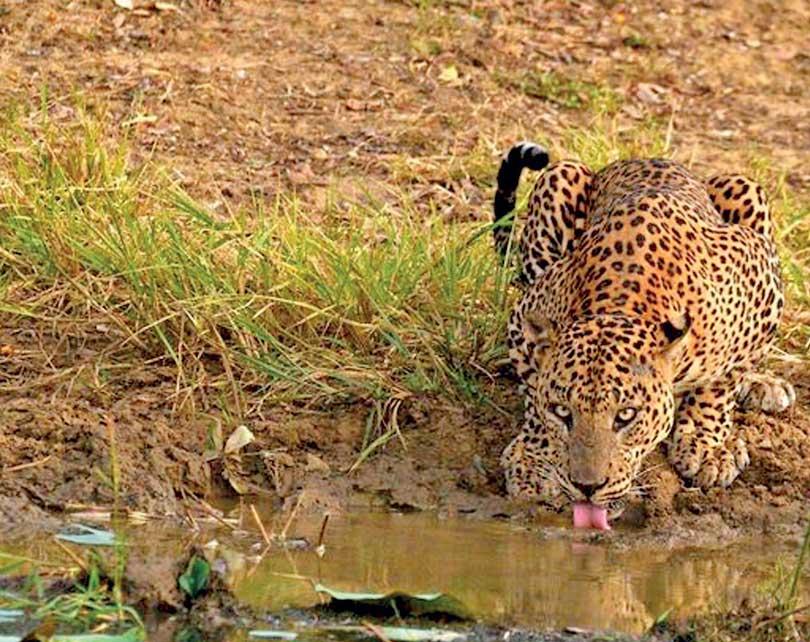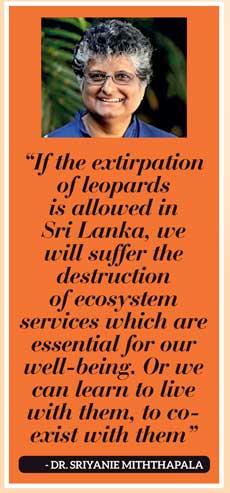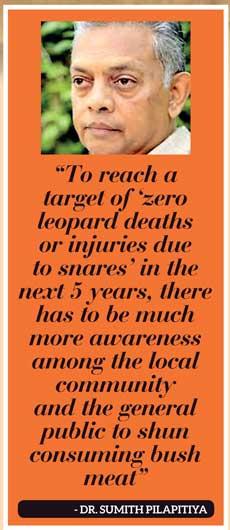01 Aug 2024 - {{hitsCtrl.values.hits}}

In Sri Lanka, the human-leopard conflict arose as leopard habitats were encroached, fragmented and as people expanded their territories in leopard-dominated regions Image courtesy: WNPS
 Rapid urbanisation has posed considerable challenges to the balance of sensitive ecosystems and inhabitants. Wildlife are usually at the receiving end of haphazard urbanisation. In Sri Lanka for instance, the human-leopard conflict arose over the last few years as leopard habitats were encroached, fragmented and as people expanded their territories in leopard dominated regions. In an attempt to add more weight on conserving the Sri Lankan Leopard (Panthera pardus kotiya) the ‘Sri Lanka Leopard Day’ was declared on August 1. As conservationists continue to stress on the importance of this charismatic keystone species, more research is being done to study the interactions between leopards and humans and minimise conflict in an increasingly shared landscape.
Rapid urbanisation has posed considerable challenges to the balance of sensitive ecosystems and inhabitants. Wildlife are usually at the receiving end of haphazard urbanisation. In Sri Lanka for instance, the human-leopard conflict arose over the last few years as leopard habitats were encroached, fragmented and as people expanded their territories in leopard dominated regions. In an attempt to add more weight on conserving the Sri Lankan Leopard (Panthera pardus kotiya) the ‘Sri Lanka Leopard Day’ was declared on August 1. As conservationists continue to stress on the importance of this charismatic keystone species, more research is being done to study the interactions between leopards and humans and minimise conflict in an increasingly shared landscape.
The tussle and tension for land
Having obtained her PhD in ‘Genetic and Morphological variation in the leopard (Panthera pardus)’ and having studied leopards in depth, Conservation Biologist Dr. Sriyanie Miththapala has been at the forefront in communicating the importance of conserving the Sri Lankan leopard to the masses. In her comments she said that in Sri Lanka, leopards are important because they exert an enormous influence, as top carnivores, over whatever ecosystem in which they live. “Without them, the interconnections in ecosystems will be disrupted, throwing the entire ecosystem out of balance. This then affects the services that ecosystems provide us, humans.”
Speaking about the growing competition for land, Dr. Miththapala said that there is a small extent of isolated land in which there are leopards outside protected areas. “We have over 330 people living in one square kilometre. Therefore, there is always going to be tussle and tension for a particular use of land. So we have a simple, clear choice. If the extirpation of leopards is allowed in Sri Lanka, we will suffer the destruction of ecosystem services which are essential for our well-being. Or we can learn to live with them, to co-exist with them,” she added.
Leopards: A national treasure
Leopards are known to strike a balance in the ecosystem, balancing the number of prey in varying ecosystems. As such they play a pivotal role as an apex predator in the food chain. “Through their impact on the species below them in the food chain, leopards can alter how a whole habitat functions,” said veteran Asian elephant researcher and conservationist Dr. Sumith Pilapitiya. “If such a species goes extinct, it will have an irreversible impact on ecosystems that they lived in and can upset the ecosystem balance.”
Despite programmes to raise awareness among communities who share a landscape with leopards, especially in the estate sector, Dr. Pilapitiya believes that a lot more needs to be done. “Due to the efforts of leopard researchers and conservation NGOs, there has been a decline in the number of leopards that are caught in snares in the hill country. But more needs to be done. We should aim for a target of ‘zero leopard deaths/injuries due to snares’ in the  next 5 years. For this to happen, there has to be much more awareness among the local community and the general public to shun consuming bush meat, as many snares are laid to catch wild boar and deer and not particularly targeting leopards. If the demand for bushmeat is reduced, our leopards will be safer.”
next 5 years. For this to happen, there has to be much more awareness among the local community and the general public to shun consuming bush meat, as many snares are laid to catch wild boar and deer and not particularly targeting leopards. If the demand for bushmeat is reduced, our leopards will be safer.”
He further appealed to visitors at National Parks like Yala, Wilpattu and Kumana to refrain from harassing leopards by crowding around them at leopard sightings. Referring to a research study conducted in Thailand and published in the journal ‘Mammalian Biology’ in 2016 he said that human presence can alter leopard movement patterns and behaviour. “The consequences of over-visitation include changes in behaviour and may include adverse impacts on health, reproduction and survival of leopards. Currently, Yala and Wilpattu are overcrowded with visitors and safari vehicles, harassing leopards by crowding around them. Kumana is fast becoming an overcrowded park. Unfortunately, little or no action is taken by the authorities to stop this type of behaviour. “
He said that even though everybody blames safari jeep drivers for this behaviour, he strongly feels that visitors to these parks, especially so-called “wildlife photographers” should be more responsible and ensure that leopards are not harassed by crowding around them. “I also appeal to the tour operators and hoteliers to stop overselling the leopard in our national parks putting pressure on the safari drivers to ‘somehow show a leopard to the guests’. This will lead to a reduction in harassment of leopards within our national parks.”
He further said that leopards are a national treasure and it is incumbent upon every single Sri Lankan citizen to ensure its safety and conservation. “We have to put our selfish needs aside and work towards ensuring the stable future for the leopards in Sri Lanka,” Dr. Pilapitiya underscored.
A unique subspecies
When the human-leopard conflict aggravated in the country over the past few years, wildlife organisations stressed on the involvement of the corporate sector in conservation activities. In 2021, the Wildlife and Nature Protection Society (WNPS) partnered with LOLC, a leading conglomerate in the country, to establish a multi-regional monitoring system for the conservation of leopards. In addition, LOLC introduced the leopard as its conservation icon.
 Explaining the ecological value of the Sri Lankan leopard, LOLC’s Chief Operating Officer and conservationist Kithsiri Gunawardana said that there are nine subspecies of leopards around the world and there are discussions as to whether it should be eight with the two subspecies found in the Russian highlands, the Amur leopard and the North Chinese leopard coming as one. “If that happens there will be only eight subspecies of leopards in the world. The whole of the African continent has only one subspecies of leopards (Panthera pardus pardus); India and the Indian subcontinent has one subspecies which is Panthera pardus fusca. In that respect, this tiny island of Sri Lanka also has its own subspecies endemic to the country. This is indeed special because the tiger, lion, jaguar and leopard are considered big cats in addition to the snow leopard found in highland areas. Out of them, it is a big deal to have our own subspecies of leopards endemic to Sri Lanka. The value of observing and seeing such a leopard heightens because of that rarity and special place the leopard has in Sri Lanka.”
Explaining the ecological value of the Sri Lankan leopard, LOLC’s Chief Operating Officer and conservationist Kithsiri Gunawardana said that there are nine subspecies of leopards around the world and there are discussions as to whether it should be eight with the two subspecies found in the Russian highlands, the Amur leopard and the North Chinese leopard coming as one. “If that happens there will be only eight subspecies of leopards in the world. The whole of the African continent has only one subspecies of leopards (Panthera pardus pardus); India and the Indian subcontinent has one subspecies which is Panthera pardus fusca. In that respect, this tiny island of Sri Lanka also has its own subspecies endemic to the country. This is indeed special because the tiger, lion, jaguar and leopard are considered big cats in addition to the snow leopard found in highland areas. Out of them, it is a big deal to have our own subspecies of leopards endemic to Sri Lanka. The value of observing and seeing such a leopard heightens because of that rarity and special place the leopard has in Sri Lanka.”
Rare sighting for tourists
Gunawardana further said this is one reason why the number one agenda for any tourist who visits a national park is to see a Sri Lankan leopard. “For tourists that arrive in the country, a visit to a national park is a must in tourist itinerary packages. Something else which is special about the Sri Lankan leopard is that Sri Lanka is the only place where the leopard is the apex predator. In India, you have tigers and lions towards the northern part of India, in Africa you get the African lion in areas where there are leopards as well. Therefore, the leopard is difficult to see because they are nocturnal. So, from a touristic perspective where you go round on safaris during the day, Sri Lanka is the only place where you are able to see leopards getting about diurnally and where they are relaxed and you can see them in their habitats. Hence, you need to leave them alone. As a species they are easily adaptable to tourist vehicles. We have seen this in Yala, Wilpattu and Horton Plains. If they are not molested, harassed and abused they would present themselves as an experience a tourist can have.”
Responsible Wildlife Photography
Speaking further about the presence of large crowds in national parks, Conservation Photographer, Author and Leopard Researcher Sankha Wanniatchi said that it could result in disrupted feeding, mating and migration patterns. “In some cases, the stress and disturbance can lead to decreased reproductive success and increased mortality rates.”
Lately, there has been a lot of competition among amateur wildlife photographers to capture the best shot of a leopard. This writer recalls an incident when a group of photographers got into the water to capture the best shot of the iconic tusker ‘Barana’ in Kala Wewa keeping the animal from going towards the water for a long period of time.
Wanniatchi further said that given the negative consequences of hype photography, it is crucial for enthusiasts and tourists to adopt responsible practices. Some recommendations are as follows:
1. Avoid Crowded Locations: If a particular site is experiencing a surge in visitors due to a wildlife sighting, it is best to avoid adding to the crowd. This helps minimise environmental damage and reduces stress on the animals.
2. Follow Park Regulations: Adhering to the rules set by park authorities is essential. This includes sticking to designated paths, maintaining a safe distance from animals, and not feeding wildlife.
3. Educate and Advocate: Use your platform to educate others about the importance of responsible wildlife photography. Advocate for sustainable tourism practices that prioritise the well-being of animals and the environment.
4. Opt for Lesser-Known Sites: Instead of flocking to well-known parks during hype periods, explore lesser-known sites that offer similar wildlife experiences without the associated crowds.
Protecting a ‘native child’ of Sri Lanka
The main objective of the WNPS and LOLC Multi-Regional Leopard Research and Conservation Project is to study the leopard populations in human-dominated landscapes and to facilitate human-leopard coexistence outside protected areas in Sri Lanka. The research is now in its third year. Speaking about its progress, Professor in Conservation Biology and the lead researcher of the project Prof. Enoka Kudavidanage said that over the past two years they collected a lot of information and built an information database. “For that we established research centres in geographically important regions. The regions include Kilinochchi, Sigiriya, Panama, Kotagala, Belihul Oya and Kalawana. We have built a network of people from wildlife officers to forest department officials to Grama Niladhari (GN) and so on.”
She said that questionnaires focused on obtaining basic information such as the presence of leopards in each GN division, the level of interaction between humans and leopards, whether there are any problems of negative impacts, records of leopard deaths, casualties and other information. “We started exploring different perceptions of people. We asked whether people could identify a leopard and we started raising awareness from school programmes onwards. We discussed people’s requirements and provided them with solutions to keep the human-leopard conflict at bay. These include taking their pet dogs into the house at night and we even started compensating people for good behaviour. As a conflict mitigation measure we implemented a compensation scheme for livestock damage under the theme ‘Stop Revenge Killing.’’’
Prof. Kudavidanage said that the study is now in its third year where they are in the process of collecting scientific information for the information that have been gathered. “This is being done by setting camera traps and systematic monitoring of the landscape. So we are trying to involve tea planters for example and provide case-by-case solutions to these issues at hand.”
Speaking about challenges, Prof. Kudavidanage said that people are fear driven and that they have to work with different stakeholders. “On the other hand, regardless of population increase, there’s a huge demand for land. So we need to improve land use management. Therefore we are in the process of identifying areas that are critical for leopards.” In conclusion, she said that a leopard is a child of Sri Lanka and that everybody is a parent. “Therefore everyone has something to do to protect this native child of Sri Lanka.”
25 Dec 2024 26 minute ago
24 Dec 2024 24 Dec 2024
24 Dec 2024 24 Dec 2024
24 Dec 2024 24 Dec 2024
24 Dec 2024 24 Dec 2024